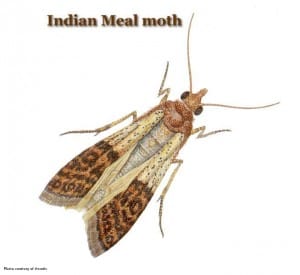Source(s):
- Kathy Flanders, Extension Entomologist, Entomology and Plant Pathology, Auburn University.
- Xing Ping Hu, Extension Entomologist , Auburn University.
The Indian meal moth is a common indoor pest. Larvae are frequently found infesting stored products, while the adults are swarming around in the house. The moth was given its common name by an early American entomologist, Asa Fitch, who found it feeding on cornmeal or Indian meal. However, you may have seen it attacking various other food materials stored at home.
Identification
Many times an infestation is noticed when moths are seen flying around the home in the evening. They are attracted to lights and often appear in front of television screens. The adults are small moths with a wingspan of about three-fourths of an inch. They can be told apart from other indoor moths by their distinctive forewings: the outer two-thirds of the wing is reddish brown; the inner third grayish white. The forewings of Mediterranean flour moths are pale gray with two black zigzag transverse lines, and those of webbing clothes moths are gold. The larvae are about a half-inch long when mature and creamy- white, with a brown head. The pupa is in a loose light-brown silken cocoon.
Damage
Adults do not feed, but they lay eggs on food materials. The larval stage causes the injury. Larvae are generally surface feeders but can feed within the grain. As they feed, larvae spin silken thread webbing throughout the infested food source. Small particles are often adhered loosely to the threads.
Larvae feed on a variety of foodstuffs. They are often found in stored grain, cereals, dried fruits, nuts, seeds, and meal products. They will feed on flour, cake mixes, powdered milk, and chocolate. Two sources often overlooked are birdseed and dry pet food. Frequently, infestations start when moths are brought in on these products.
Biology
Adults fly around in the evening. An adult may lay up to 350 eggs, singly or in groups, on food materials such as grain, dried food, and especially pet food. The larvae feed on or in the food materials for a few weeks. When mature, they often migrate out of the food source and wander about in search of a suitable place to spin their cocoons for pupation. They are frequently found making cocoons in cracks and crevices on cupboard tops, shelves, ceiling corners, and walls. There are about 6 to 8 generations a year in the South, but the number can vary depending on environmental factors.
Management
- Prompt action is important in preventing loss of foods stored on kitchen or pantry shelves.
- First locate infested food products and packages. Check all potentially infested materials, even those unopened boxes or containers, including birdseed and pet foods.
- Remove all containers, utensils, and shelf paper from the infested area, and clean thoroughly. Use a vacuum cleaner to pick up hiding insects and spilled materials in cracks and corners to make sure there is no lingering moth problem. Empty the vacuum cleaner and discard the vacuum cleaner bag after use to prevent re-infestation. You may then use hot soapy water to clean the pantry, but it will not provide moth control. Destroy cocoons that may be found in the cracks between shelves, moldings, and doorframes, on ceilings of cupboards, or where room walls and ceiling meet. In many cases, a thorough cleanup will control the insects.
- Uninfested open packages must be transferred to containers with tight-fitting tops.
- In difficult cases, a household formula of insecticide (Pyrethrins or Resmethrin) is recommended after a cleanup. Apply the solution with a paintbrush only to cracks and crevices. Allow paint to thoroughly dry before putting food materials back. Take great care to avoid contamination of utensils and food.
- One fairly new control practice is the use of pheromone traps in confined areas, such as a cupboard. Such traps are available from garden catalogs that specialize in pest management products.
- Continue to observe the infested area for several months after treatment.
Prevention
Avoid long-term storage of meal products or grains at home, but if you must, store susceptible foods in insect-tight containers: airtight glassware, metal or heavy plastic containers, or in the refrigerator or freezer. Do not purchase crushed or damaged packages of cereal or grain products.
Center Publication Number: 217
- Green June Beetles - September 24, 2013
- Indian Meal Moths - September 24, 2013